The Fascinating World of Rodents
July 21, 2025Are Capybaras Endangered in 2025? Status, Threats & How Many Are Left
July 22, 2025Can Capybaras Be Potty Trained? Honest Vet Advice, Real Owner Reviews & Step-by-Step Training Guide.
Introduction:
Ever looked into those calm, glassy eyes of a capybara and thought, “Could this giant, water-loving rodent really learn to use a potty like a cat or dog?”
I’ve had the same question, and as a vet who works with exotic animals (and proudly adores capybaras), I hear it all the time.
Capybaras are the world’s largest rodents; some males can weigh over 170 lbs, and let’s be honest: their bathroom habits are… unique. If you’re thinking of welcoming one into your home, you’re probably really hoping they don’t treat your living room like an open field.
In this guide, I’m sharing everything I’ve learned, from professional veterinary experience to candid stories from real capybara owners, about the ups and downs of potty training these gentle “water pigs.” We’ll cover:
- Whether potty training is even possible?
- Why do they poop in water (and sometimes… eat it)?
- How to gently shape better bathroom behavior?
My tone here is warm, straightforward, and a little playful, like two pet lovers swapping stories over coffee. Because here’s the truth: potty training a capybara isn’t as easy as housetraining a dog. But it’s possible, and I’ll help you figure out how, with clear steps, honest expectations, and a lot of patience.
Table of Contents
Can Capybaras Be Potty Trained?
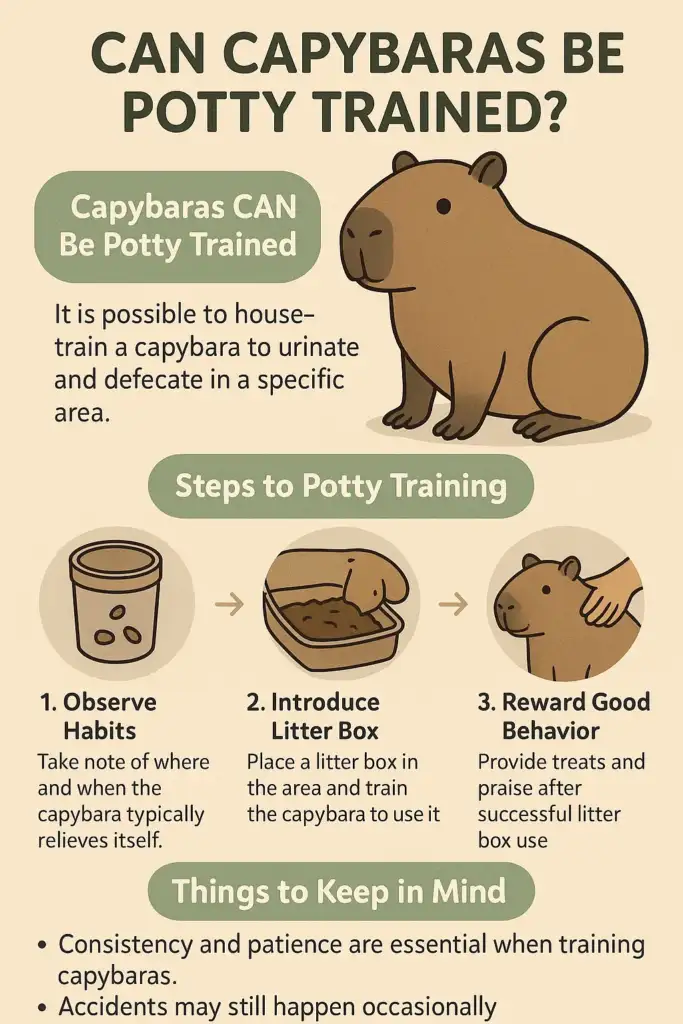
Let’s get straight to it:
Yes, capybaras can be potty trained, at least partially.
But it’s not a black-and-white answer. Think of it more like a spectrum than a switch.
Capybaras are surprisingly intelligent (more on that soon), and they naturally prefer to do their business in a designated area. In the wild, they often pick a specific spot, usually close to water, as a communal toilet zone. This natural behavior gives us a head start when trying to train them at home.
Many capybara owners have successfully guided their pets to use a potty spot, whether that’s a litter box, a puppy pee pad corner, or even a kiddie pool. And yes, it does cut down on random droppings around the house.
But here’s the catch: it takes a lot of patience, consistency, and a good understanding of capybara behavior. Don’t expect your capy to be as reliably housetrained as a cat. Accidents will happen, especially if they’re startled, overly excited, or just in one of their moods.
As one seasoned capy parent put it:
“They can learn, but it’s on their terms, not because they want to please you.”
So yes, you can potty train a capybara to a certain degree. But go in with realistic expectations. It’s less about enforcing strict human rules and more about working with their instincts.
And speaking of instincts… that’s the next big piece of the puzzle.
Let’s break down what makes capybaras tick, and poop, the way they do.
Why Capybaras Poop in Water (It’s Not Just Gross – It’s Instinct)
If you’ve ever watched a capybara at the zoo or online, you might’ve noticed something… unusual.
They don’t just swim in water.
They poop in it.
Yep, these gentle giants will happily waddle into a pond, pool, or even their water bowl to do their business. And while that might seem a little gross to us, for a capybara, it’s pure instinct.
Capybaras are semi-aquatic animals, which means water isn’t just a place to chill; it’s part of how they survive.
In the wild, pooping in rivers or ponds helps hide their scent from predators. Think jaguars, caimans, and anacondas, all of whom consider capybaras a tasty snack.
By letting their droppings float downstream, capybaras reduce the chances of being sniffed out.
Pretty smart, right?
This instinct doesn’t just disappear in captivity. Many pet capybaras still prefer to relieve themselves in water by default. And guess what?
That’s actually great news for potty training.
Some owners take full advantage of this quirk by offering a large tub or shallow pool as their capybara’s designated toilet. One owner on a capybara forum said cleanup was a breeze because:
“They just go in the water bowl every time.”
Of course, not every capy will be this neat, but it’s a helpful starting point. If you give them access to an “approved” water source, one you can clean easily, it can drastically reduce random accidents around the house.
Just one big rule:
Never restrict a capybara’s access to water in an attempt to control their bathroom habits.
They need water not just for instincts, but for their skin health, emotional well-being, and overall happiness.
(They’re called water pigs for a reason.)
Instead, work with their instincts, not against them.
You’ll see how in the training guide coming up.
Fun side note:
Some experts also believe capybaras poop in water simply because they spend so much time lounging and swimming there. So why get out of the bath just to poop elsewhere?
Whether it’s for survival or convenience, understanding this watery bathroom behavior is step one in setting your capybara up for potty training success.
Capybaras Eat Their Own Poop
(Yes, Really, and It’s Actually Important)
Brace yourself for this one:
Capybaras eat their own poop.
Yep, I said it. And yes, you read that right.
Before you cringe too hard or start second-guessing your life choices, let me explain: this isn’t just some random gross habit. It’s actually a vital part of their digestion. And it’s not unique to capybaras either, rabbits and guinea pigs do it too.
The Two Types of Capybara Poop
Capybaras produce two kinds of droppings:
- Normal Poop – the dry, firm pellets you’re probably imagining
- Cecotropes – soft, nutrient-rich droppings that they eat… right out of the source
That’s right. Capybaras often perform a kind of yoga move to grab these cecotropes directly as they come out. Strange? A little. But it’s also brilliant biology.
Why They Do It (And Why You Shouldn’t Stop Them)
Capybaras are what we call hindgut fermenters. That means the real magic of digestion, breaking down their fiber-heavy grass diet, happens late in the digestive tract, specifically in a section called the cecum.
By the time food reaches this area, it’s already passed through most of the system. So… they don’t absorb everything the first time.
Enter: the cecotrope.
This second round of poop gives them another shot at pulling out important nutrients, especially vitamins and beneficial bacteria.
In simple terms, it’s a natural, healthy form of recycling.
So when you see your capybara snacking on yesterday’s output, don’t panic.
- It’s normal.
- It’s healthy.
- And you should never try to stop it.
They mostly do this at night, quietly and efficiently. That’s why you might find a few dry pellet poops in their potty area, but rarely any mushy mess. The soft stuff has already been handled (literally and nutritionally).
What This Means for You (and Potty Training)
Here’s the good news:
- Capybara poop doesn’t smell nearly as bad as you’d expect.
It’s often described as musky or earthy, way less offensive than dog or cat waste. - Since they eat the soft stuff, you’ll mostly be cleaning up the dry pellets.
But here’s the takeaway:
Never punish your capybara for pooping, especially with outdated tactics like rubbing their nose in it.
They won’t understand. To them, poop isn’t strictly “waste”; it’s part of their biology.
Instead, focus on designing a clean, calm potty environment where they want to go.
We’ll get to that soon.
For now, just embrace the weirdness.
Because when it comes to capybaras, poop isn’t gross, it’s fascinating.
Are Capybaras Smart Enough to Be Trained?
Short answer: Yes, but not in the way you might expect.
Capybaras have a bit of a laid-back, lazy reputation.
(Those viral memes of them soaking in hot springs don’t help.)
But don’t let the chill vibes fool you, capys are surprisingly smart.
In my experience as a vet, I’d say they rank right up there with pigs and dogs in terms of intelligence.
But here’s the key: they just think differently.
Not Dumb, Just Differently Motivated
One longtime capybara owner once joked that in South America, locals call capys “the dumbest animals on the planet.”
But after raising her own, she realized they’re not dumb at all, just selectively cooperative.
That’s honestly the perfect way to describe them.
Capybaras can learn:
- Simple commands
- Names
- Routines
- And yes… potty habits
But unlike dogs, they’re not out to impress you.
They’re more like a big, aquatic guinea pig crossed with a slightly sassy cat.
They’ll listen if there’s something in it for them.
The Secret Sauce: Food, Comfort, and Trust
Capybaras respond best when training feels rewarding.
Rustle a veggie bag, and most of them will come running.
Use gentle repetition and treats, and they’ll start picking up patterns fast.
Take Caplin Rous, one of the most famous pet capybaras:
- He learned to shake hands in 15 minutes using a simple treat-reward method
- He picked up the “turn in a circle” trick after just a couple of tries by following a popsicle.
(Yes, Popsicles count as advanced training tools in the capy world!)
Social Animals = Trainable Animals
Capybaras bond deeply with their humans.
They’re herd animals at heart, and if they see you as part of their “group,” they’ll pay attention to what you’re doing. That trust becomes a powerful foundation for all kinds of training, including potty training.
In fact, I’ve worked with capy patients who:
- Respond to their names
- Come when called
- And choose to potty in designated areas, as long as the area is easy, familiar, and… not too far away.
But Let’s Be Honest: They Can Be Stubborn
Here’s the flip side of capy smarts:
If something seems inconvenient or boring, they’ll just… not do it.
Example:
If the potty zone is across the yard and their favorite pool is closer, guess where they’re going?
That’s why your job as a trainer is to meet them halfway.
Design a setup that makes the “right” behavior easier than the “wrong” one.
Think Toddler, Not Trained Soldier
Capybara intelligence is a lot like that of a toddler:
- Sometimes brilliant
- Sometimes hilariously stubborn
- Always observing
They’re not domesticated the way dogs are; dogs have been bred for thousands of years to follow human rules.
Capybaras? They’re still mostly wild at heart.
But if a capybara trusts you, and the routine makes sense to them, they’ll try.
And over time, they can learn to consistently potty in the right place, especially if you stay calm, positive, and consistent.
So what’s the next step?
Now that you understand how they think, we can get into what to actually do.
Let’s dive into the step-by-step potty training process. It’s not magic, but it works.
Step-by-Step Potty Training Guide
Your path to fewer messes, more success (and a happy capy!)
Ready to potty train your capybara? Grab your gloves, treats, and most importantly… your patience. This guide blends proven methods from real capybara owners with what I’ve learned as an exotic animal vet. Training won’t be instant, but with consistency and care, it will happen.
Step 1: Set Up a Designated Potty Area
Capybaras naturally prefer a “go-to” toilet zone, in the wild, they’ll often return to the same latrine near water. You can use this instinct to your advantage.
Here’s what to do:
- Pick a spot that’s easy to clean and always accessible.
- Common setups:
- A low kiddie pool or shallow tub with water
- An oversized litter box lined with hay, shavings, or pee pads
- A cement mixing tray from the hardware store (I use one myself!)
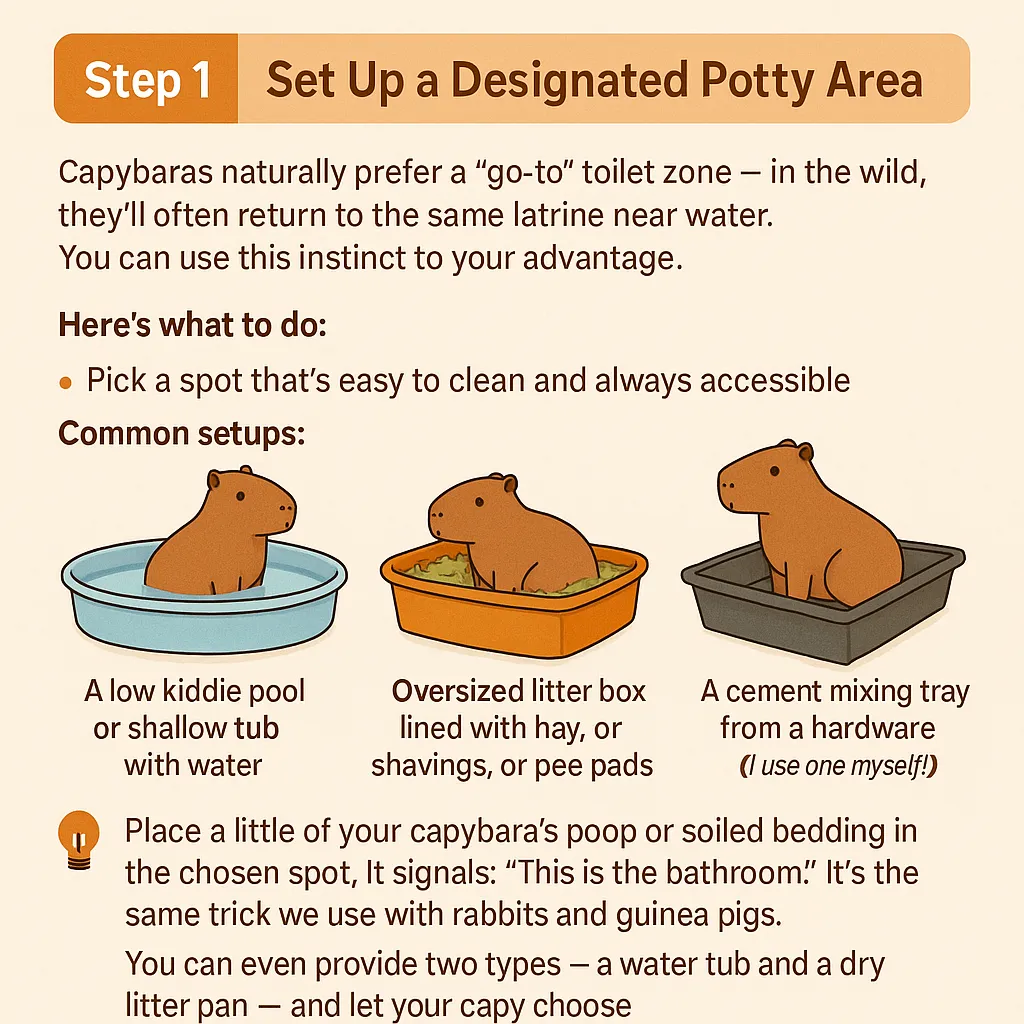
Tip:
Place a little of your capybara’s poop or soiled bedding in the chosen spot. It signals: “This is the bathroom.” It’s the same trick we use with rabbits and guinea pigs.
You can even provide two types, a water tub and a dry litter pan, and let your capy choose.
Step 2: Observe Their Timing and Habits
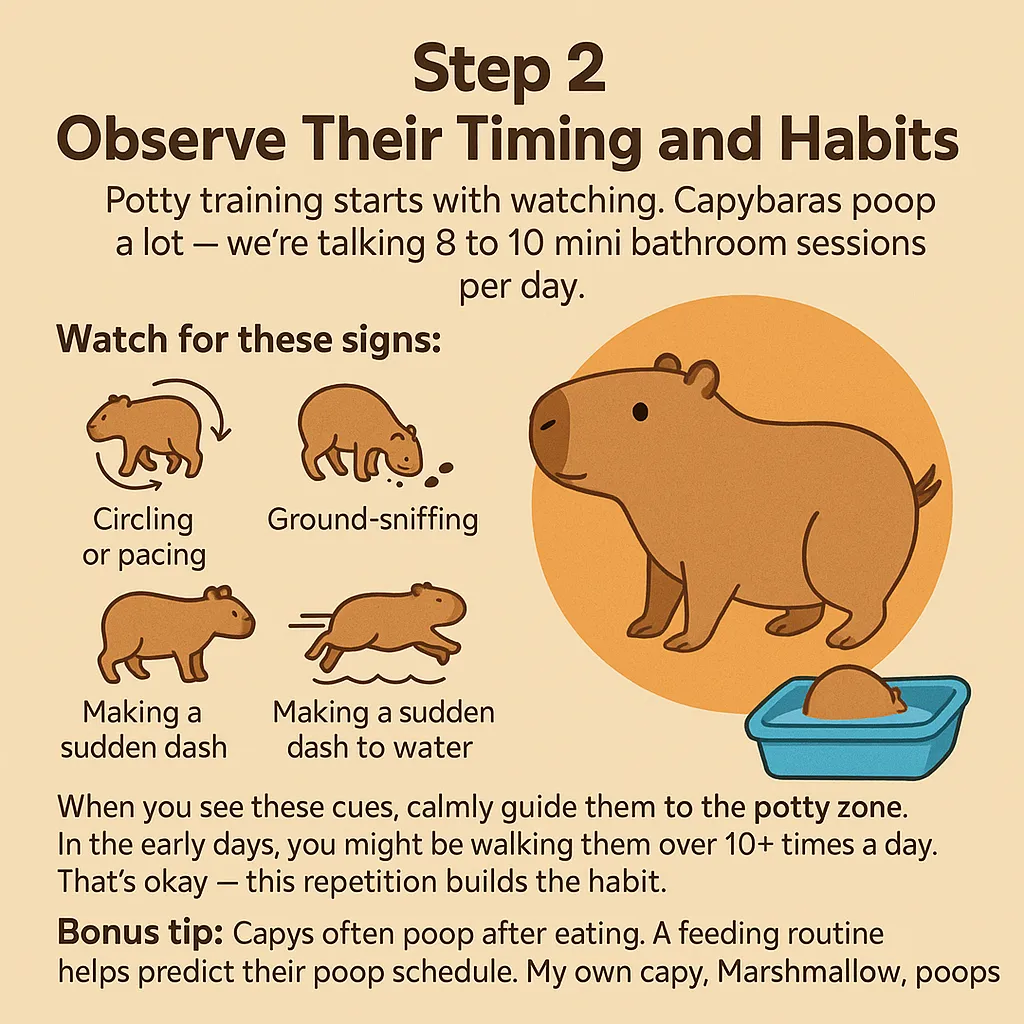
Potty training starts with watching. Capybaras poop a lot; we’re talking 8 to 10 mini bathroom sessions per day.
Watch for these signs:
- Circling or pacing
- Ground-sniffing
- Lifting their tail
- Making a sudden dash to the water
When you see these cues, calmly guide them to the potty zone.
In the early days, you might be walking them over 10+ times a day. That’s okay , this repetition builds the habit.
Bonus tip:
Capybaras often poop after eating. A feeding routine helps predict their poop schedule.
My own capy, Marshmallow, poops like clockwork 20 minutes after breakfast, right in his water tub.
Step 3: Use Positive Reinforcement (Always)
Here’s your golden rule:
Praise the good. Ignore the bad.
When your capybara uses the potty area:
- Celebrate!
- Offer a treat (carrots or apple bits are great)
- Use a happy voice, “Good boy!” or “Good girl!” goes a long way.

Capybaras thrive on food and affection.
One owner shared that her capy would poop in the right place just to hear praise and get head scratches, no treat needed.
❌ Never scold or punish them for accidents.
They won’t understand, and you’ll risk damaging your bond.
Just clean it up (with an enzymatic cleaner), make mental notes, and try again. Stay calm and positive, it works.
Step 4: Keep It Clean (Yes, Really Clean)
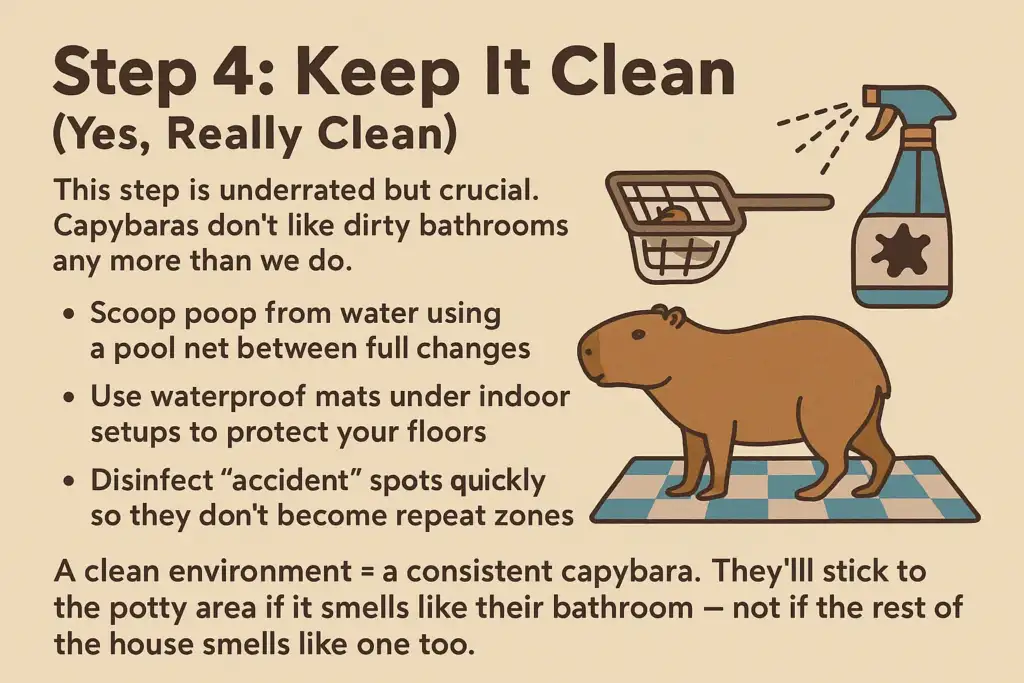
This step is underrated, but crucial.
Capybaras don’t like dirty bathrooms any more than we do.
- Clean the potty area often (daily for water tubs, more for litter boxes)
- Scoop poop from the water using a pool net between full changes.
- Use waterproof mats under indoor setups to protect your floors.
- Disinfect “accident” spots quickly so they don’t become repeat zones
A clean environment = a consistent capybara.
They’ll stick to the potty area if it smells like their bathroom, not if the rest of the house smells like one too.
Step 5: Be Patient and Consistent
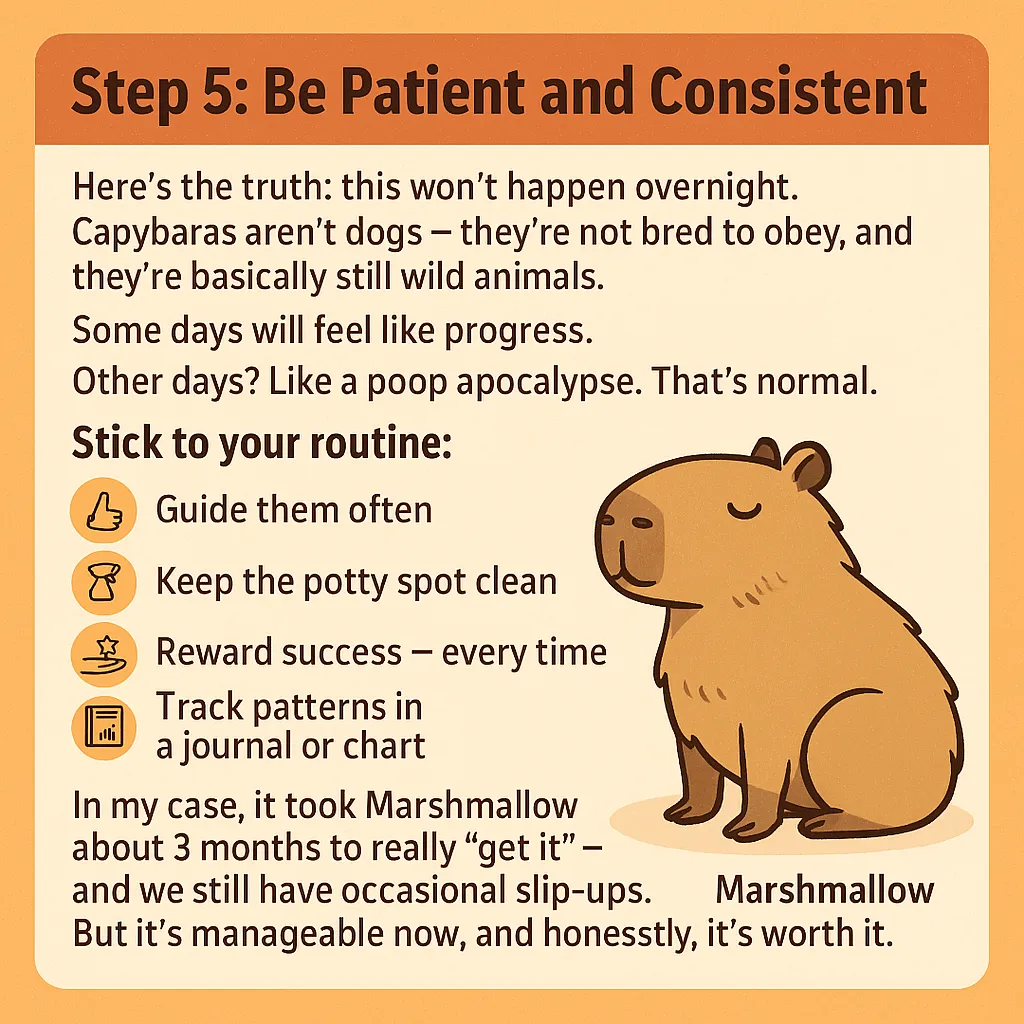
Here’s the truth: this won’t happen overnight.
Capybaras aren’t dogs; they’re not bred to obey, and they’re basically still wild animals.
Some days will feel like progress.
Other days? Like a poop apocalypse.
That’s normal.
Stick to your routine:
- Guide them often
- Keep the potty spot clean.
- Reward success, every time.
- Track patterns in a journal or chart (we’ve included a free tracker at the end!)
In my case, it took Marshmallow about 3 months to really “get it”, and we still have occasional slip-ups. But it’s manageable now, and honestly, it’s worth it.
Step 6: Troubleshoot and Adapt
Not every capybara will follow the script. That’s okay, adjust as needed.
- Refuse the litter box? Try different materials (hay, shavings, pee pads)
- Keep pooping in the same “wrong” corner? Make that their potty zone.
- Live in a big house? Set up multiple potty stations at first.
- Prefer water? Lean into the tub method.
- Prefer dry? Some capys do better with wood pellets or soft mats.
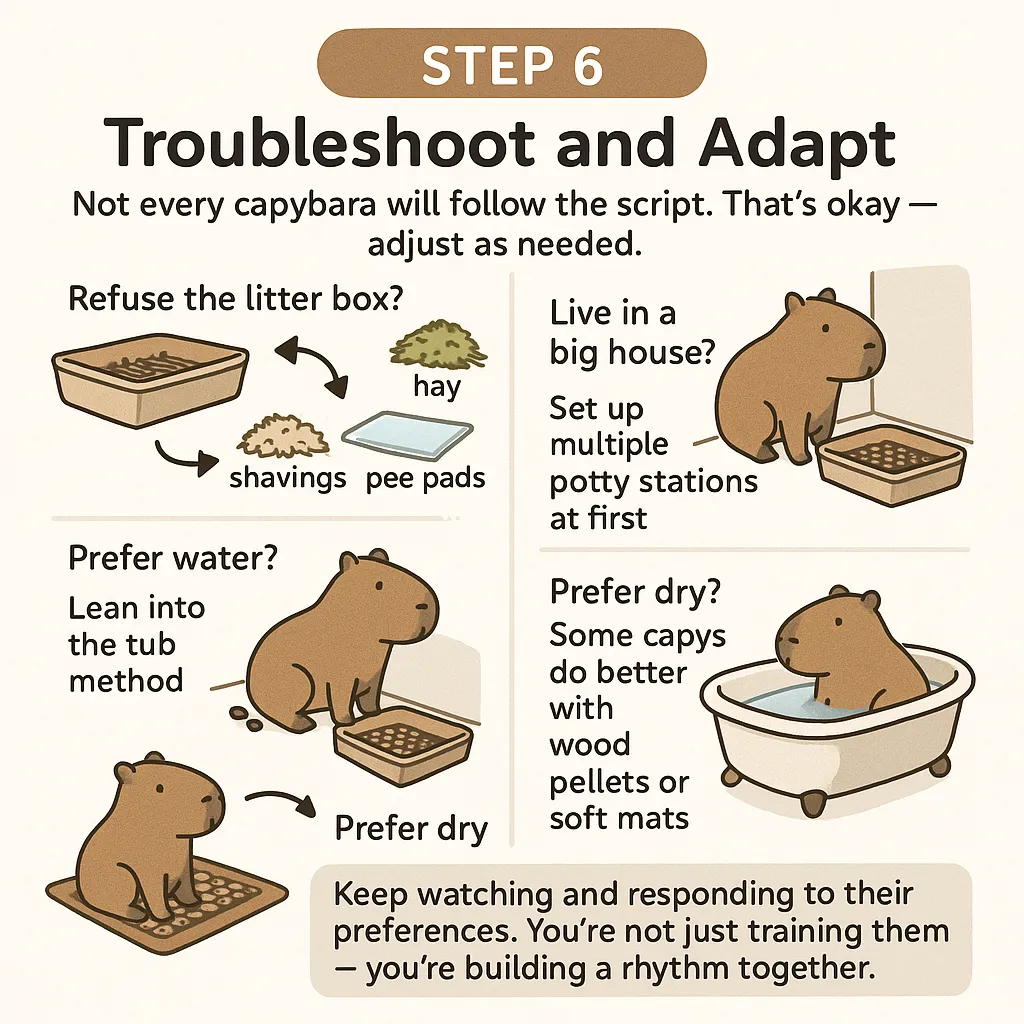
Keep watching and responding to their preferences. You’re not just training them, you’re building a rhythm together.
If You Remember One Thing…
Potty training a capybara is a partnership.
You’re meeting a semi-wild, highly social creature where they are, and slowly guiding them toward human-friendly habits.
With time, love, and a little elbow grease, most capybaras can be trained to do their business in the right place.
The journey is messy. The wins are real. And the bond you build? Worth every scoop.
Baby vs. Adult Capybara Training
Start early if you can, but it’s never too late.
So, you’ve got a capybara pup (yep, baby capybaras are adorably called pups)?
Congratulations, you’re in the best position to shape good habits early.
But even if you’re working with an adult, don’t worry. Training is still possible, it just comes with a few extra quirks.
Training Baby Capybaras: Easier Than You Think
Baby capybaras are naturally more adaptable.
If they’re under a year old, they haven’t locked into bad habits yet, which makes them much easier to guide.
In fact, many pups almost train themselves when given the right setup.
They tend to:
- Avoid pooping near their sleeping space
- Waddle to a corner or a water bowl to relieve themselves
- Bond quickly with humans and respond well to praise
I’ve seen 2-month-old capybaras arrive in a new home, pick a bathroom corner on day one, and stick to it. All the owner had to do was reinforce the behavior.
One baby capy even potty-trained with only verbal praise, no food needed, because she was so attached to her human.
Pro tip:
Start training as soon as your pup has settled in and feels safe.
Introduce the potty area, use praise or treats, and let their instincts work for you. The earlier you start, the more “normal” it feels for them.
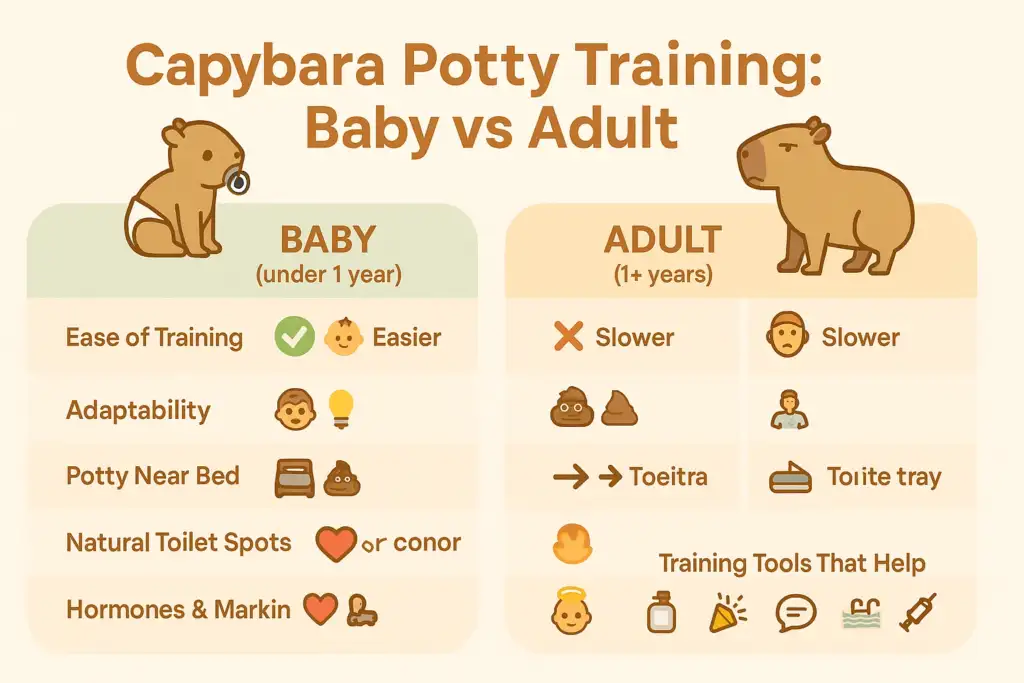
Training Adult Capybaras: Totally Doable, Just Be Patient
Now, if you’re working with an adult capybara, it is a bit trickier, but not impossible.
Older capys tend to come with built-in habits. If they’ve been peeing wherever they want for years, you’ll need time and consistency to reshape that behavior.
Plus, once they hit sexual maturity (usually around 1–2 years), things change. Especially for males.
Adult capybaras may:
- Start marking territory with pee or poop
- Become more dominant or stubborn.
- “Forget” previous potty routines when hormones kick in.
I’ve seen well-trained young capys go rogue during puberty. It’s not defiance, it’s biology. They’re saying, “This is mine now.”
But don’t give up.
Instead, double down on what works:
- Provide a large, appealing toilet option (a pool or low tray they want to use)
- Keep their environment clean and remove scent triggers.
- If marking becomes a major issue, neutering or spaying may help, especially with males (talk to a vet who knows exotic pets)
Can Other Pets Help?
Funny enough, capybaras are social learners.
If they see another animal using a designated potty spot, like a dog going on a pee pad, they may copy the behavior.
You might not have a trained capybara mentor at home, but if you’ve got a tidy dog, your capy might just follow their lead.
Set Realistic Expectations
Let’s be honest: training an adult capybara can be a long journey.
But that doesn’t mean it’s pointless.
You can absolutely teach them to use a specific area, it’ll just take:
- More time
- More reminders
- More flexibility on your end
Some adult capys become nearly spotless. Others stay a bit more… freelance.
I’ve met both: one that was practically litter-box perfect, and another that acted like the whole house was fair game.
So if you’re training an older capybara, go in with patience, humor, and the understanding that progress matters more than perfection.
Male vs. Female Bathroom Behavior
Same species, different instincts (and yes, they both can be trained).
Does the sex of your capybara really make a difference in potty training?
The short answer is: not in how you train them, but yes, their natural behaviors might influence how often you’re scooping poop off your floor.
Male Capybaras: Marking Machines (Sometimes)
Male capybaras, even the sweet, cuddly ones, often have one big biological mission: mark their territory.
Here’s why:
- They have a scent gland on their nose called the morillo, which secretes a sticky scent.
- They also have anal glands for marking with poop and pee.
- Together, these make males quite eager to say, “This is mine!” even if it’s your living room rug.
If your male isn’t neutered, expect the occasional:
- Pee dribble on furniture
- Random pellet poop where it doesn’t belong
- Scent-rubbing on corners, doors, or your leg (if you’re lucky)
This isn’t “bad behavior”, it’s territorial instinct.
Neutering can reduce the urge to mark, but it’s not a total fix. Some dominant males still feel the need to lay down their signature scent.
One capy owner even told me her male used to pee on freshly laundered clothes, because they didn’t smell like him yet. (If that doesn’t scream “alpha energy,” I don’t know what does.)
In homes with multiple males, you might even see a “marking war”: one marks, the other marks over it, rinse and repeat. That can lead to stray droppings in all kinds of places.
💡 Pro tip:
Give your male a designated marking object, like a log or corner mat, and don’t scrub it as often. If he’s got “his spot,” he might stop targeting your sofa.
Female Capybaras: Less Messy, But Still Wild at Heart
Female capys tend to be a bit tidier indoors. They’re less likely to scent-mark just for the sake of it.
But they have their own quirky habits.
For example:
- Some females use poop as a signal, leaving droppings near a male to show interest or claim social space.
- During estrus (heat), a female might pee more frequently or in unusual spots to advertise she’s ready to mate.
If you only have females and no males nearby, you may barely notice any of this.
But if she lives with a male, or thinks you might be a male (awkward but not uncommon), you might notice some extra communication… in puddle form.
Spaying can reduce hormonal marking, but it’s not something most vets recommend unless medically necessary, since spaying exotic animals can be tricky.
Training Tips for Both Sexes
- You don’t need two separate training plans.
Males and females both learn well with the same routine, structure, and positive reinforcement. - Just watch for marking patterns.
With males, you might need to be more strategic, guiding them to mark the right place instead of your belongings. - Females are usually neater, but may have occasional marking behaviors around heat cycles.
In short:
- If you want fewer marking battles, a solo female might be slightly easier.
- If you fall in love with a male, just be ready for some extra cleanup, and maybe a strategically placed marking post.
My Vet Take: Pick Personality, Not Plumbing
Whether your capy is male or female, you can potty train them.
Their individual quirks, bold, shy, clean-freak, chaos gremlin, will matter more than their sex in the long run.
Choose the capybara you bond with, not the one you think will poop less.
And whatever you end up with? Just train patiently, clean often, and embrace the occasional weirdness.
Common Mistakes to Avoid
Even the best-intentioned capy parents mess this up. Here’s how to get ahead of the curve.
If you’ve made a few potty training mistakes already, don’t worry, so have I.
The good news? Most of these are easy to fix once you understand how capybaras think.
Here are the most common pitfalls I’ve seen (and sometimes personally stumbled into):
1. Punishing or Yelling at Your Capybara
Let’s say it louder: never punish a capybara for an accident.
No yelling.
No nose rubbing.
No rolled-up newspapers.
Capybaras don’t connect punishment with what they did wrong. Instead, they’ll just become scared, anxious, or even more accident-prone. A stressed-out capy may increase their marking behavior, not stop it.
👉 If you catch them mid-poop, say something like “Uh-oh, let’s go potty!” and gently redirect.
👉 If it’s already happened? Clean it up quietly and move on.
Training works best when your capy feels safe and understood, not fearful or confused.
2. Being Inconsistent
Capybaras are creatures of habit. If you’re inconsistent, you’re sending mixed messages.
Examples:
- Letting them pee on the couch once, then scolding them the next time.
- Moving the potty spot every few days.
- Having one person enforce the rules while another laughs off “cute accidents.”
🧠 Set a clear routine and stick to it:
- Same potty spot
- Same reward system
- Same verbal cues (if you use them)
The more predictable things are, the faster your capy will learn.
3. Ignoring Their Natural Preferences
Not all capys are the same. Some like water. Some prefer hay.
If your capybara clearly wants to poop in water, but you’re forcing a dry litter box… you’re setting yourself up for frustration.
I’ve seen people struggle for weeks trying to train their capy to use pellets or pads, only to have it click immediately after switching to a water tub.
💡 Lesson: don’t impose a method. Observe, adapt, and work with their instincts.
4. Not Cleaning Thoroughly (or Often Enough)
If the potty area gets gross, your capybara might abandon it altogether.
One owner wondered why her capy stopped using the kiddie pool.
Turns out, she was only changing the water once a week.
🤢 For a capybara, that’s like being asked to poop in a swamp.
Same goes for accidents: if you don’t fully clean the spot (with an enzyme cleaner, not just a paper towel), the scent remains. To a capybara, that smells like a bathroom invitation.
🧼 Keep the potty clean and neutralize accident spots completely.
Their noses are stronger than yours; make sure it doesn’t smell like pee to them.
5. Giving Free Rein Too Soon
A big mistake? Letting your capy explore the whole house before they’re fully trained.
That’s like giving a toddler keys to a mansion and hoping they find the toilet every time.
Start small:
- One capy-proof room
- Easy access to their potty zone
- Expand their territory gradually once they show consistent success.
This phased approach reduces accidents and builds confidence in both of you.
6. Using Carpet or Slippery Floors
Capybaras and carpets? Not a good mix.
Carpet = sponge
Tile = skating rink
Their webbed feet aren’t made for slippery surfaces. And once they mark a carpet… good luck getting that smell out.
Better options:
- Hardwood, laminate, or concrete
- Waterproof mats
- Outdoor rugs you can hose off
- Rubber runners for traction
Trust me: your future self will thank you for planning ahead.
7. Not Providing Enrichment or Social Time
Here’s one people don’t expect, but it matters.
Capybaras are social, emotional creatures. If they’re lonely, bored, or anxious, they may start marking or having accidents as a form of stress relief or attention-seeking.
I’ve noticed my own capy, Marshmallow, is more likely to skip the potty if he’s in a bad mood or feeling neglected. Once, after I was gone all day, he marked my bed, and I’m pretty sure it wasn’t personal. Just… emotional.
💡 Fixes:
- Daily pool or water access
- Toys to chew and play with
- Company (you, another pet, or even background music)
- A stable routine
A happy capy is a cleaner capy.
Recap: Capybaras Learn Best When You Work With Them
| Mistake | Why It Backfires | What to Do Instead |
| Punishing | Causes fear and confusion | Use gentle redirection + rewards |
| Inconsistency | Breaks the learning pattern | Stick to a routine everyone follows |
| Forcing a method | Disrespects natural instincts | Observe and adapt to your capy’s preferences |
| Poor cleaning | Encourages re-marking | Use enzyme cleaners + frequent water changes |
| Too much freedom | Overwhelms them | Gradually expand the space after success |
| Wrong flooring | Causes accidents + anxiety | Use mats, washable rugs, or rubber flooring |
| No enrichment | Leads to stress-based messes | Provide play, attention, and a calm environment |
Avoiding these mistakes will save you weeks of frustration and cleanup.
Most are simple once you see the world through your capybara’s eyes.
And if something isn’t working?
Pause, reassess, and don’t be afraid to tweak your approach. They’re not being naughty, they’re just being capybaras.
Recommended Tools & Products
Gear that makes potty training your capybara way less messy (and more manageable).
Potty training a capybara isn’t just about patience; the right tools can make all the difference. After years of hands-on experience and learning from other capy owners, here’s a go-to list of products that make life easier during the potty journey:
1. Oversized Litter Box or Pan
Forget cat litter boxes, they’re way too small.
Here’s what works better:
- Giant rabbit pans or small dog litter boxes
- Concrete mixing trays (cheap and surprisingly effective)
- Plastic storage bins with one side cut for easy entry
- Kiddie pools or low livestock troughs for water-loving setups
🧪 My pick: A large under-bed storage box for dry indoor use + a 4-ft plastic kiddie pool outside.
2. Safe Bedding or Litter
For dry setups, avoid clumping cat litter. Instead, try:
- Paper-based litter (recycled pellets are great)
- Aspen or kiln-dried pine shavings
- Timothy Hay (many capys poop while munching, multitasking champs!)
🛒 Pro tip: Capybaras often love a pile of hay inside their litter tray. It turns the potty zone into a comfy, familiar grazing area.
3. Potty Training Pads
Disposable puppy pads can save your floors early on. Use them:
- To line potty zones
- Around the edges of water tubs
- Under litter boxes for splashes or accidents
🔐 If your capy loves chewing, try reusable, washable pee pads or secure pads under a grate or mat.
⚠️ Avoid putting pads everywhere, some capys will treat any pad-like surface as a toilet.
4. Enzyme Cleaner & Deodorizers
Essential. Period.
Capybaras have strong noses; if they smell old pee, they might return to the scene of the crime.
Best options:
- Nature’s Miracle or Simple Solution (enzyme-based pet cleaners)
- White vinegar + water (1:1 spray) for natural odor neutralizing
- Activated charcoal bags to freshen air without irritating perfumes
🧽 Keep these on hand and clean up every accident thoroughly.
5. Comfortable Floor Mats
Slick floors = capybara panic.
Capy feet aren’t built for traction on tile or hardwood.
Try:
- Rubber-backed entry mats (washable and grippy)
- Foam puzzle mats for play areas (but not ideal for potty spots)
- Outdoor rugs you can hose off
💡 I lined Marshmallow’s litter area with rubber mats; any “misses” get caught there, and the cleanup is way easier.
6. Pool Net & Gloves
Using a water tub or pool as a toilet? You’ll want:
- A small fishnet or pool skimmer to scoop poop without dumping water
- A pair of rubber gloves for scrubbing trays, wringing pads, or daily spot cleaning
Trust me, these are lifesavers for your back and your sanity.
7. Treats & (Optional) Clicker
Reward success right away with:
- Baby carrots
- Apple bits
- A piece of banana or watermelon (in moderation)
A clicker isn’t necessary, but if you’re already using one for other training, you can click as they potty correctly and reward. Some capys catch on quickly with this extra signal.
8. Printable Tracker & Checklist (Bonus!)
Want to track progress (and stay motivated)? Use a potty log!
We’ve created a simple downloadable tracker you can use to:
- Mark daily wins and accidents
- Spot time-based patterns
- Adjust your strategy over time.
📝 Some owners turn it into a fun challenge: “3 days in a row, no accidents!”
Start Simple, Add As You Go
You don’t need every item on this list from day one. Start with the basics:
- A large pan or water tub
- Safe bedding
- Enzyme cleaner
- Rewards
Then build your setup around what your Capybara responds to.
Every capy is different; let their habits guide your gear choices.
Real Owner Stories & Tips
Because sometimes, the best advice comes from someone who’s been knee-deep in capy poop.
Every capybara is a little different, and so is every owner’s experience with potty training. Some get lucky, some get creative, and some just learn to laugh through it.
Here are real anecdotes from capybara owners who’ve lived it, cleaned it, and figured out how to make it work. (Names have been changed, but the stories are real.)
“Water Bowl = Toilet”
“I was shocked at how easy it was,” says one owner of two young capybaras.
“The moment I brought them home, they hopped into the dog’s kiddie pool to pee and poop. So I just kept a large bowl of water in their pen, and they used that. Rare accidents. Clean-up is a breeze.”
This is one of those dream scenarios where the capybaras trained themselves, all because the owner leaned into their natural instincts.
The takeaway?
Sometimes, just offering a water tub from day one solves the problem before it starts.
“Carpet Woes”
Another owner shared a cautionary tale about her adult male, Jeffrey:
“He was a potty angel as a baby… until he hit 18 months. Then he started marking our rug. We’d clean it, he’d mark it again, especially after shampooing. Like he wanted to ‘reclaim’ it.”
Eventually, they gave up on saving the rug. They rolled it up, exposed the hardwood underneath (which he didn’t like peeing on), and gave him a sacrificial mat near his litter box.
Now? He marks the mat, not the whole room.
💡Smart tip: If your capy insists on marking, give them a designated item to anoint, and remove the temptation elsewhere.
“Praise = Powerful Reward”
A vet tech shared this about her capybara, Daisy:
“She’s so bonded to me that a gentle head rub and a ‘Good girl!’ meant more than food. After pooping in her litter pan, I’d clap lightly, praise her, and she’d purr and wag her ears. If she had an accident, I’d stay neutral. She caught on fast.”
Not every capy responds to social praise, but this is a great reminder:
Capybaras crave connection. If your bond is strong, your attention can be more motivating than any treat.
(I admit, I do the same “yay!” dance when Marshmallow poops in the pool. He totally gets a kick out of it.)
“Setbacks Happen”
One owner moved to a new home and was surprised when her previously perfect capybara, Choco, started having accidents:
“He peed on the floor the first day, totally confused. I realized I had to re-teach him the routine in the new space. I kept him in one room with his potty for a week. He bounced back.”
Moving, adding a pet, or even changing your schedule can throw a capy off.
💡 Don’t panic, just go back to basics.
Most capys rebound with a little structure and patience.
“The Almost There Capybara”
One owner summed it up with honesty and humor:
“Cappy reliably pees in his water tub. Poop, though? Not so reliable. He drops pellets while walking, totally unaware. We just sweep a few up daily. It’s like having a Roomba that dumps dirt instead of picking it up.”
I love this. It’s real.
And honestly? Many owners settle into this kind of rhythm.
Capybaras often release small, dry poop pellets on the move, not out of defiance, just… because they’re built like that.
If the major stuff is handled (i.e., urine and big business in the right spot), a few “cocoa puffs” on the floor is a fair trade.
What These Stories Have in Common
None of these owners had a perfect journey, but they all adapted, stayed kind, and worked with their capybaras instead of against them.
Whether your capy:
- Immediately uses the water tub,
- Decides your carpet is its canvas,
- Needs emotional support and praise,
- Or leaves a poop trail like a bread crumb path…
There’s a solution. And usually, that solution involves a little compromise and a lot of understanding.
These stories are a reminder: you’re not alone.
Capybaras aren’t cookie-cutter pets, and that’s what makes them both challenging and wonderful.
Frequently Asked Questions (FAQs)
Because let’s be real: everyone has a few.
Do capybaras only poop in water?
Not always, but they prefer it. In the wild, pooping in water helps hide their scent from predators. At home, many pet capybaras carry this habit over. If there’s a water tub available, they’ll usually choose that as their toilet.
That said, they’ll also poop on land, especially if they feel safe or the water’s too far away. You might see 90% of the poop in the water, and a random pellet or two on the grass. That’s totally normal.
Training isn’t about perfection; it’s about creating a routine they can stick to most of the time.
Does capybara pee smell bad?
Not really, not compared to other pets. Their herbivore diet and love of bathing keep odors pretty low.
Poop is often described as earthy or musky. Urine has a scent, but it’s nowhere near as strong as, say, cat pee.
Males with their morillo scent gland might add a spicy, “old bookstore” smell when marking, but it’s not offensive. With good hygiene and ventilation, most capy homes don’t smell like pet homes at all.
Should I stop my capybara from eating its poop?
Nope, let them do their thing! Capybaras eat cecotropes (soft nutrient-rich poop) to absorb extra vitamins and support gut health. It’s not gross to them, it’s biology.
They don’t eat all their poop, just the important kind. Think of it as their built-in supplement routine.
How long does it take to potty train a capybara?
It depends on age, personality, and consistency.
Babies might catch on in a few weeks.
Adults can take several months.
Progress is rarely linear. You’ll have great days and messy ones. That’s normal. “Potty trained” for a capybara usually means mostly reliable, not perfect.
Can capybaras use a human toilet?
Funny idea… but no.
They aren’t built to climb or balance on toilet seats, and their poop (tiny pellets) doesn’t exactly flush cleanly. You’re better off with a floor-level water tub or oversized litter area. It’s safer, more natural, and way easier for everyone involved.
Will neutering or spaying help with potty training?
Sometimes, especially in males.
Neutering can reduce hormonal marking, which means fewer rogue poops or surprise pee puddles.
But it’s not a magic fix. You still have to train.
Spaying can slightly mellow hormonal females, but since their marking is less intense, it’s often not needed unless for medical reasons. Always consult an exotic vet first.
What if my capybara refuses the litter box or keeps flipping it over?
Check your setup:
1. Too small?
2. Wrong bedding?
3. Box too light and easy to play with?
Try:
1. Heavier containers
2. Water-based potties
3. A turf-lined tray (some capys love peeing on “grass”)
4. Securing the box in a corner or attaching it to something solid
When in doubt, follow their lead. If they’re always using the kiddie pool, make that their potty station.
Are capybaras clean animals?
Yes, especially for their size.
They groom themselves, soak in water daily, and don’t smell strongly.
They might track a little water or poop around, but with regular cleaning and the right flooring, they’re surprisingly tidy.
They shed lightly and enjoy being clean. If their living area is fresh, they’ll stay that way too.
🎯 Wrapping It Up: What Potty Training a Capybara Is Really About
Potty training a capybara isn’t just about poop placement; it’s about patience, partnership, and learning to speak “capy.”
These aren’t your typical pets. They’re still wild at heart, with instincts that don’t always align with life indoors. But with the right setup, kind guidance, and realistic expectations, you can teach a capybara to keep your home relatively tidy.
You’ll have days where you wonder why you ever thought this was a good idea…
…and then they’ll nuzzle your leg, purr with their eyes closed, or trot proudly to their water tub like, “Look what I did!”
And you’ll remember: this is why.
💡 Veterinary tip:
If your capybara suddenly changes their potty behavior dramatically, don’t assume it’s just stubbornness , it could be a medical issue. Always check with an exotic vet if something seems off.
🐾 Final Word (From One Capy Lover to Another)
Can capybaras be potty trained?
Yes, not perfectly, not like a dog, but enough to live peacefully together.
All it takes is:
- A little strategy
- A lot of consistency
- And a heart big enough to embrace their weirdness
You’ve got this.
And when you realize your giant water pig is choosing their potty corner like a pro, you’ll feel proud of both of you.
Happy training, and here’s to fewer puddles and more proud capy poops! 🛁💩✨
